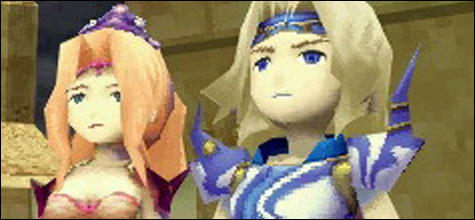
CRYING TIME FFIV is one of few games of its era to evoke real emotions.
They say there are no new ideas in Hollywood, but when it comes to advancing sequels, remakes, and general nostalgia exploitation at the expense of more creative concepts, the major motion-picture studios have nothing on the video-game industry. Square Enix has now released its fourth different iteration of the landmark game Final Fantasy IV, this time for the Nintendo DS in all its 3-D graphic glory. In the video-game world, however, it makes sense to update these things, and FFIV both retains its original charm and feels upgraded enough to justify revisiting.
Cecil is a troubled Dark Knight in the monarchy of Baron. Already ambivalent about Baron’s “might makes right” policy, Cecil finally snaps after the king — who’s been acting odd lately — orders him out to sack a peaceful magic-loving village. To quell an uprising, the king sends Cecil and his lifelong friend Kain on what seems an insignificant mission, though in fact it will take them on an epic journey involving brainwashing, bratty ninjas, spoony bards, romance, airships, trips to the moon, and ultimately, self-discovery.
This wasn’t the Square folks’ first attempt at a grand story line, and it wouldn’t be their last, but in 1991 its scope and ambition were unprecedented. The characters range from the noble Cecil to the eccentric Cid to the mysterious, wise Lunarian FuSoYa. The romance between Cecil and his girlfriend Rosa is hardly matched in subsequent FF entries. Indeed, FFIV is one of a few games of the era to evoke real emotions; when two characters sacrificed themselves for the greater good, I nearly burst into tears. The dialogue has been retranslated to clarify certain situations, but some of the character development feels a touch rushed. The narrative economy works here, however — the game is long enough as it is.
In the development process, Square focused on the storyline, so combat and gameplay get short shrift. Several staples of the RPG genre are absent. Characters aren’t especially customizable; for the most part their abilities are fixed. You don’t even get to control which spells the magic users learn. The story also dictates which characters are in your party at a given time — which means you have to battle monsters with what you have. Random battle encounters, standard in the ’90s but a relic today, have survived into this edition, and they annoy with their frequency. And the battles against the scrub monsters can get repetitive. But the boss battles more than compensate. These require strategy, planning, and creativity, as you seek to find and exploit some specific unusual weakness, such as whether a spell is effective when reflected back against the user, or whether a particular weapon can produce a one-hit kill.
Square has added some new features, all of them optional. You can summon a new character called Whyt to replace a member of your party in battle. You train Whyt by playing a series of mini-games, none of which is very much fun. A better addition is the new feature that offers rewards for completing each dungeon’s map. But even without those, gamers who played the original SNES version will want to check this one out for the new translation and the 3-D cinema sequences. Final Fantasy fans who haven’t yet tried FFIV will appreciate the fully realized storyline. And newcomers will find that FFIV’s user-friendliness makes it a great entry point into the franchise. This is a nostalgia trip worth taking.